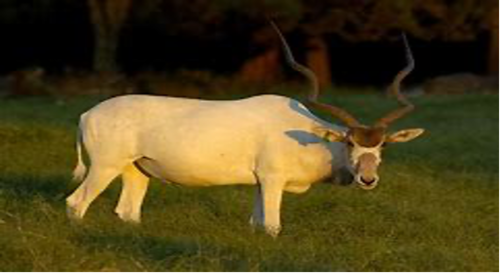Written by Chibuike Ugwu
Scientific Name: Addax nasomaculatus.
Status: Critically Endangered.
Threats: Uncontrolled hunting, drought, and the extension of pastoralism.

Africa is a land that has been blessed with the most some of the most unique animals in the world. One of those is the addax (also known as the white antelope or screw horn antelope). It is most desert-adapted African antelope, formerly found throughout most of the Sahara but nearly exterminated in the wild in the last quarter of the 20th century by poaching from motorized vehicles. The addax’s most striking feature is its long spiral horns.
Male addaxes weigh 100–135 kg (220–300 pounds) and have a shoulder height of 95–115 cm (37–45 inches). Their horns are 76–109 cm (30–43 inches) long. Females are nearly as tall as males and only 10–20 percent lighter; their horns are thinner than the male’s but just as long. A stocky build and sturdy, rather short legs give the addax endurance but not speed. It was easily run down on the gravel plains and plateaus that were once part of its natural habitat. The addax’s coat is lightest in summer and smoky gray in winter. The hindquarters, tail, underparts, and legs are white, as are a conspicuous face mask and mouth that contrast with a dark brown forehead tuft and gray muzzle. The throat is covered with a short brownish beard.
While other antelopes of North Africa—gazelles and the related scimitar-horned oryx—penetrate the central Sahara after rainfall has made the desert bloom, only the addax and the slender-horned, or Rhim gazelle (Gazella leptoceros) live there in all seasons. Both are equipped with broad hooves that are adapted for traveling efficiently on sand, enabling them to inhabit the extensive accumulations of sand called ergs that serve as refuges from poachers.
Other adaptations for desert life are developed to a high degree in the addax, including a highly reflective coat, an ability to extract all the water it needs from plants and to conserve that water by excreting dry feces and concentrated urine, and an ability to tolerate a rise of daytime body temperature by as much as 6 °C (11 °F) before resorting to nasal panting to cool down. In the hottest weather, addaxes rest by day and feed at night and early morning when food plants have absorbed the maximum moisture from the air. The addax employs its short, blunt muzzle to graze coarse desert grasses, and when these are unavailable it browses on acacias, leguminous herbs, and water-storing plants such as melons and tubers.
The addax once ranged from the Atlantic to the Nile, on both sides of the Sahara. Herds of 2–20 animals were typical, but sometimes them addax migrated and aggregated in herds of hundreds where rain had revived the vegetation.
Despite the Addax’s many adaptations for survival, it has no answer for the actions of man as uncontrolled hunting has reduced the species to ranging in only a few remote areas of sand dunes in the desert. The International Union for Conservation of Nature and Natural Resources (IUCN) has classified the addax as a critically endangered species since 2000. The number of survivors in the wild is estimated at fewer than 100 animals in Mauritania, Niger, and Chad. However, several hundred addaxes are maintained in American and European zoos and on private ranches. The best hope for the species’ survival as a wild animal is the breeding of captive animals and their reintroduction into securely protected areas within their old natural range. Efforts to restore populations in Tunisia and Morocco are underway.
References:
Estes, Richard. “Antelope”. Encyclopedia Britannica, 9 Mar. 2020, https://www.britannica.com/animal/antelope-mammal. Accessed 7 April 2021.
Theys, Michael. “Top 10 most endangered animals in Africa”. Africafreak, Top 10 Most Endangered Animals in Africa (& Where to Find Them) (africafreak.com) Accessed 7 April 2021.


